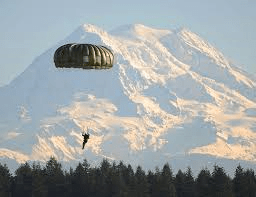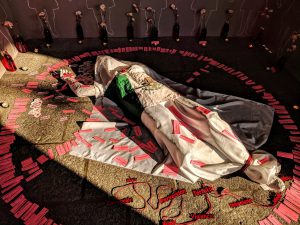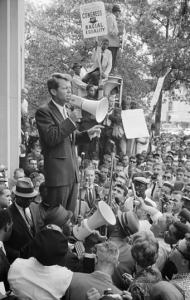Winner of theSpring 2018 StMU History Media Award for
Best Article in the Category of “Social History”
What is courage? What is strength? Perhaps it is being ready to fight for your nation even when your nation isn’t ready to fight for you.1 Imagine jumping out of a plane for the sole purpose of protecting that same nation. That is exactly what the 555th Infantry, the first all African-American unit, did during World War II. They stood in the doorway of the plane with a hundred pounds of gear strapped to their backs and await the jumpmaster’s commands.2 They hear “load” and “follow the trooper in front to your spot” and “wait.” As your turn approached, you looked down and saw the world below you as the wind ripped around your face. The men in the 555th battalion stood out among the rest of those troopers because they had to fight to be able to stand on the edge of that plane’s doorway and stare down fear in the face. They did this for the sake of a nation that segregated and mistreated them.

During World War II, paratroopers would leap from planes and parachute behind enemy lines to gather intelligence or fight from the inside of a battle and work their way out. Many, including the US military, believed that to be a paratrooper one needed specialized training, extreme physical fitness, courage, and, up until the Triple Nickles, white skin.3 The 555th Parachute Infantry Battalion was not legitimately formed until December 31, 1943. Before officially becoming a unit, many of the African-American soldiers did menial things like cooking and cleaning.4 Enlisted African Americans were segregated from white soldiers and regularly assigned to those kinds of duties. While thousands of American soldiers were fighting the Axis powers, African-American soldiers were fighting discrimination to be able to fight alongside those overseas. However, at Fort Benning, Georgia, one enlisted African American, Walter Morris, decided he wanted to change that. Morris and his company were assigned the task of cleaning up the training areas where the white paratroopers prepared for parachute duty. Morris saw the struggles and low morale of his company, so he decided to give them a goal to strive towards. Each night after all the other infantry parachute units finished training, Morris and his men would run through the same course that they saw performed earlier that day. This course included 34-foot towers, mock aircrafts, and pull-up bars.5 They secretly went behind the backs of authority figures just to feel a new sense of purpose. Not long after this, Morris saw his men transform into soldiers. However, that all came to a crashing halt when the company’s secret training sessions came to the attention of the commanding General Ridgely Gaither as he drove past the training field one night. The next day Morris was called to his office while the rest of the battalion awaited their fate.
Morris walked into the office and explained what he and his men had been up to and accepted full responsibility for their actions. However, in an unexpected turn of events, the general said, “I’m going to tell you something you don’t know, Walter Morris,” and proceeded to praise him and his men for taking initiative.6 The general officially assigned Morris as the first sergeant of the newly created 555th Parachute Infantry Unit as a test platoon. As Morris left, he said, “My head was in the clouds… My heart almost bust right there.”7
The 555th Infantry, also affectionately nicknamed the Triple Nickels, began training in January 1944. The men knew that they had a difficult challenge ahead of them, because they had to be better than any other unit to be considered equivalent. There were different stages of training that they had to undergo to be able to graduate. Stage A consisted of extreme physical fitness from daylight to dark, with classes on equipment and orders in between. In Stage B they began using equipment to complete obstacles on a much higher level. One of these training sessions included the Trainasium, which was a large obstacle course in the air that was used for agility exercises, and which would test a trainee’s ability to carry out simple instructions and activities above ground level as well as help the trainee conquer any fears of heights he might have.8 Therefore, the paratroopers worked and trained twice as hard as the white paratrooper units.9 Soon, the 555th became one of the best trained battalions in the army. When graduation arrived on February 8, 1944, seventeen paratroopers received their wings. Morris was the first African-American paratrooper to parachute out of a plane. They were the very first all African-American paratroop infantry, while also taking a step in the direction of ending segregation in the military. They were pushing the government towards racial justice and beating the odds of being an African-American paratrooper. Not long after they graduated, they became more well-known, and other African Americans began to enlist to be a part of the company. So many men joined up that the company grew into a battalion. The Triple Nickels patiently waited to be assigned to go join the fight in Europe, but the assignment they received was not what they had expected. The battalion was assigned to a 300-man smokejumper firefighting component in Camp Pendleton, Oregon.10

The Japanese had created a type of incendiary bomb that Americans commonly called balloon bombs. Japanese Lieutenant-General Reikichi Tada led a program that designed a four-meter balloon capable of delivering explosives up to seventy miles.11 After nearly a year of research and testing, his team came up with a design capable of remaining aloft for thirty hours at an altitude of 25,000 feet for over hundreds of miles.12 The Japanese would launch the balloons from submarines, which would release a 5-kilogram bomb once it touched down. The bombs were intended to land in forests and cause massive forest fires, which would put the lives of Americans at risk. The American navy would not send out aircraft or ships to stop these submarines because they did not see it as a large threat. The Japanese kept modifying and perfecting their balloons to the point that they could fly all the way from Japan to America. At one point, America had approximately ten thousand balloon landings. They needed someone to be able to get in and disarm them quietly. The Triple Nickles were disappointed in their new highly classified mission, but were pleased that they had been assigned a task to help America in the war.
These bombs were initially discovered by a young preacher, his wife, and five teenagers. They stopped because they had found a truck stuck in the mud. They all got out and were heading over to offer some help. However, his wife and the five children spotted a large balloon not far from where they were standing. Before the young pastor could tell them not to touch it, a large blast exploded from within the balloon. All six innocent Americans died in the explosion and the army and forest service then started discovering more of these balloon bombs. Shortly after, the army began Operation Firefly. Although the Triple Nickles did not get to go overseas, they began to see the importance of their mission and the contribution they would make, even if no one was watching.

This 555th Infantry Battalion was assigned to the Forest Fire Service as part of Operation Firefly.13 Operation Firefly was tasked to prevent forest fires, halt forest fires, or prevent an explosion if the balloon bombs were still armed. The Forest Service was having a hard time battling the fires because they could not get men into the forest fast enough to stop the fires while they were still small. The men took part in training to learn how to parachute down into rugged terrain and set up a fire line to stop the fires. The battalion also went through demolition training so that they could disable unexploded bombs. They were given fifty-foot ropes in case they got stuck in trees, and a parachute. The men started wearing old football helmets with chicken wire as face masks to protect them from branches and rough landings. The unit would stay in the fire zones and forests for days at a time, and when they extinguished a fire, they would then hike back to base miles away. The military and Forest Services kept the missions of the Firefly operation secret. They did not want Americans to know that America was under attack on its own soil, and they did not want the Japanese to know that their small-scale attacks were successful. The 555th Parachute Battalion became the first and only “smoke jumpers.”14
In the spring of 2010 the Pentagon paid tribute to the Triple Nickels for being the US Army’s first all-black paratrooper unit and for their contributions to the safety of America.15 By the end of the war, the 555th parachute infantry battalion logged more than 1,200 smoke-jumping missions. The 555th infantry smokejumpers’ assistance in Operation Firefly helped save American lives. But it also helped to keep the hopes of Americans positive during the war by keeping the balloon bombs a secret. They succeeded where they were not expected to succeed and overcame pitfalls that were put there. It had nothing to do with the color of their skin. It had to do with the bravery that each one of those men had inside of them.
- Tonya Lee Stone, Courage has no color: The story of the Triple Nickles: America’s first Black paratroopers (Somerville, Mass.: Candlewick Press, 2013), 3. ↵
- Tonya Lee Stone, Courage has no color: The story of the Triple Nickles: America’s first Black paratroopers (Somerville, Mass.: Candlewick Press, 2013), 5. ↵
- Tonya Lee Stone, Courage has no color: The story of the Triple Nickles: America’s first Black paratroopers (Somerville, Mass.: Candlewick Press, 2013), 9. ↵
- Jacqueline M. Hames, “Jumping into History: The Army’s First African American Paratroopers,” Soldiers 2, (2014): 1. ↵
- Robert F. Dorr, “555th Parachute Infantry confronted challenges, bigotry,” Army Times 61, no. 30: 41 (2001): 2. ↵
- Jacqueline M. Hames, “Jumping into History: The Army’s First African American Paratroopers,” Soldiers 2, (2014): 1. ↵
- Tonya Lee Stone, Courage has no color: The story of the Triple Nickles: America’s first Black paratroopers (Somerville, Mass.: Candlewick Press, 2013), 23. ↵
- Tonya Lee Stone, Courage has no color: The story of the Triple Nickles: America’s first Black paratroopers (Somerville, Mass.: Candlewick Press, 2013), 32. ↵
- Jacqueline M. Hames, “Jumping into History: The Army’s First African American Paratroopers,” Soldiers 2, (2014): 1. ↵
- Jacqueline M. Hames, “Jumping into History: The Army’s First African American Paratroopers,” Soldiers 2, (2014): 2. ↵
- Ross Allen Coen, Fu-go: The Curious History of Japan’s Balloon Bomb Attack on America (Lincoln, NB,: University of Nebraska Press, 2014), 17. ↵
- Ross Allen Coen, Fu-go: The Curious History of Japan’s Balloon Bomb Attack on America (Lincoln, NB,: University of Nebraska Press, 2014), 17. ↵
- Jacqueline M. Hames, “Jumping into History: The Army’s First African American Paratroopers,” Soldiers 2, (2014): 2. ↵
- Ross Allen Coen, Fu-go: The Curious History of Japan’s Balloon Bomb Attack on America (Lincoln, NB,: University of Nebraska Press, 2014), 32. ↵
- Brendan Manley, “‘Triple Nickle’ para jumpers honored,” Military History 10, (2010): 14. ↵



90 comments
Martina Rodriguez
The author paints a chilling scene in the first paragraph, however, the real hook happens in her last sentence. Sadly, that was the reality the infantry men faced. I was shocked to hear of the segregation practices happening while at war. I don’t mean to sound naive, but I had thought that such social differences were put aside for the sake of war. It was nice to read that Gaither looked beyond skin color and saw the men for the dedicated soldiers that they were. I was shocked to read about the balloons, as I had never heard of such a thing before this article.
Jorge Martinez
I usually forget that the American military was segregated, even in during war. I find it amazing that these soldiers of the 555th Parachute Infantry fought for their country and even more on how they received their training. The way they secretly trained proved that they were loyal to their home country and I am glad they received some praise.
Megan Copeland
This article shows the dedication of the 555th battalion because they were willing to put their lives on the line for their country, even when their country wasn’t ready for them to. I will never understand why people of color weren’t allowed to serve their country. I believe that anyone who is brave enough to volunteer to serve in the military should be welcomed with open arms. I think this article was really well structured and well written.
Adrian Cook
Walter Morris had dreams and goals he wanted to achieve and he set out to accomplish it. Being that African Americans were still going through segregation in the military Morris wanted things to change. I’m happy he stood up for himself because if not, The Triple Nickels would’ve never existed. It’s a great article hearing how they trained in the night behind everyone’s back and continued to better themselves for whatever mission they would be sent on.
Raymond Munoz
Wow, just wow! First, the writing structure of the article was great. Second, the story itself is amazing. The author structured this article so beautifully that really makes a push for the purpose and influence of this story. The 555th story is proof that there is reasonable limits to progressing in an environment that won’t allow you too, without having anyone hurt out of hatred. Usually in the stories of segregation we hear about the brutality or extremes of one side or another, but here the men of the 555th did what they could to improve themselves and then just let their actions do the talking. We can all learn a lot from just focusing on ourselves, not talking, and just doing.
Taylor Rech
I was drawn to this article because I find information about wars very interesting, and this article provided me with information that I had never heard about World War II. I was inspired by how Walter Morris motivated his fellow African American soldiers enough to go out and prepare to be soldiers even when they knew that it was likely that they could never even get a chance to go out onto the battle field. His leadership led to their recruitment and the creation of their infantry that saved many American lives that people did not even know were being saved. I admire the bravery and determination of those men and highly praise them for their willingness to fight without immediate credit for a nation that at the time was depriving them of certain rights.
Daniel Linstead
True inspiration to see how no matter what they wanted to help there country and that they did. This article captures the hard work and the determination the 555th infantry put in to help their country in a time of need. It is sad that they weren’t able to help at first but that didn’t stop their drive to at some point help. It was made difficult for them by not getting the equipment they needed but it still didn’t stop them. That is pure bravery in my eyes.
Gabriela Ochoa
I found this article inspiring, I myself am going into the Army after college and law school but I have always wanted to be in the Airborne division. So to hear this story for the first time is very inspiring. These men gave up their lives for a country as you said that didn’t try and protect them. To many in the military doing that job would have seemed like a small job and one that wouldn’t get recognition but they did it anyways because they wanted to help. They weren’t provided with the equipment that they need but they made their own and did an amazing job at protecting the country even at home. I’m glad that they finally got the recognition they deserved for defending the country.
Austin Pena
Congrats on your nomination and for writing a great article. I have always been interesting in skydiving and hope to do it one day. I have not heard of the 555th Battalion before reading this article, but i did find it interesting that these individuals had to put more work in just because of their color of their skin.
Christopher Sanchez
I was always scared of heights especially falling in mid air but not for 555th parachute infantry. They were the first African American infantry to disarm bombs on American soil without alarming any Americans. It’s sad to see that people of color weren’t able to help their country because of the color of their skin. Everyone has the right to serve their country no matter what race or color. The 555ht infantry never gave up on hope and would be later be recognized as brave hero’s in the United States. This article showed the bravery and the hard working men of the 555th infantry.